The Importance of Safe Pedagogical Practices in Nappy Changing Routine
VerifiedAdded on 2022/08/24
|6
|910
|18
Report
AI Summary
This report examines the critical role of safe and effective pedagogical practices in early childhood education, specifically focusing on the routine of nappy changing. It references the Early Years Learning Framework (EYLF) and emphasizes the importance of hygiene, creating a relaxed and social environment, and fostering positive educator-child relationships. The report highlights how educators can utilize nappy-changing times to interact with children, promote learning, and understand each child's personality. It also outlines the necessary steps for a safe and hygienic nappy-changing procedure, including preparation, proper handling, and disposal of materials. The conclusion reinforces the significance of following established practices to ensure children's safety, well-being, and development. This analysis provides a comprehensive overview of best practices in early childhood education and care, as demonstrated by the student assignment.
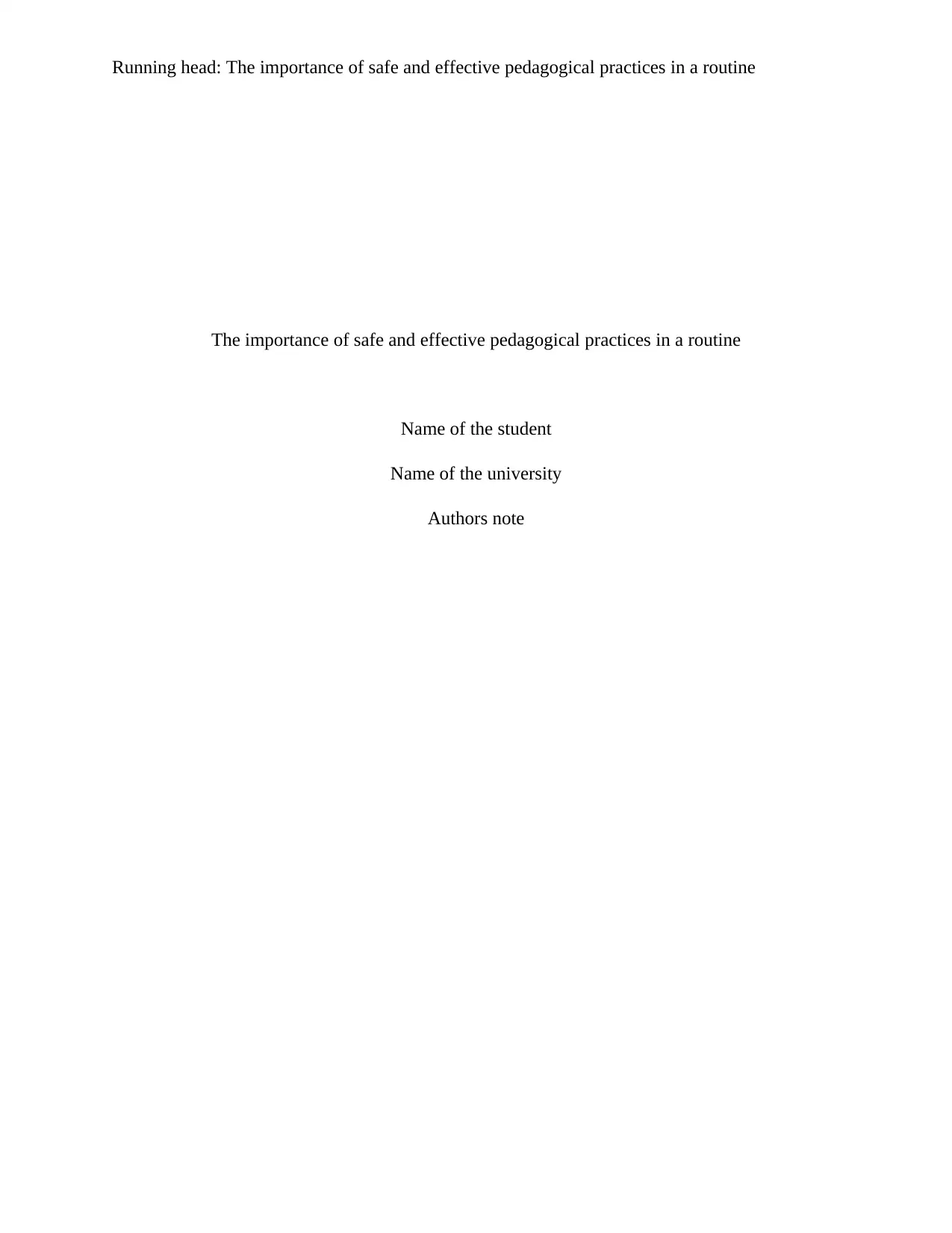
Running head: The importance of safe and effective pedagogical practices in a routine
The importance of safe and effective pedagogical practices in a routine
Name of the student
Name of the university
Authors note
The importance of safe and effective pedagogical practices in a routine
Name of the student
Name of the university
Authors note
Paraphrase This Document
Need a fresh take? Get an instant paraphrase of this document with our AI Paraphraser
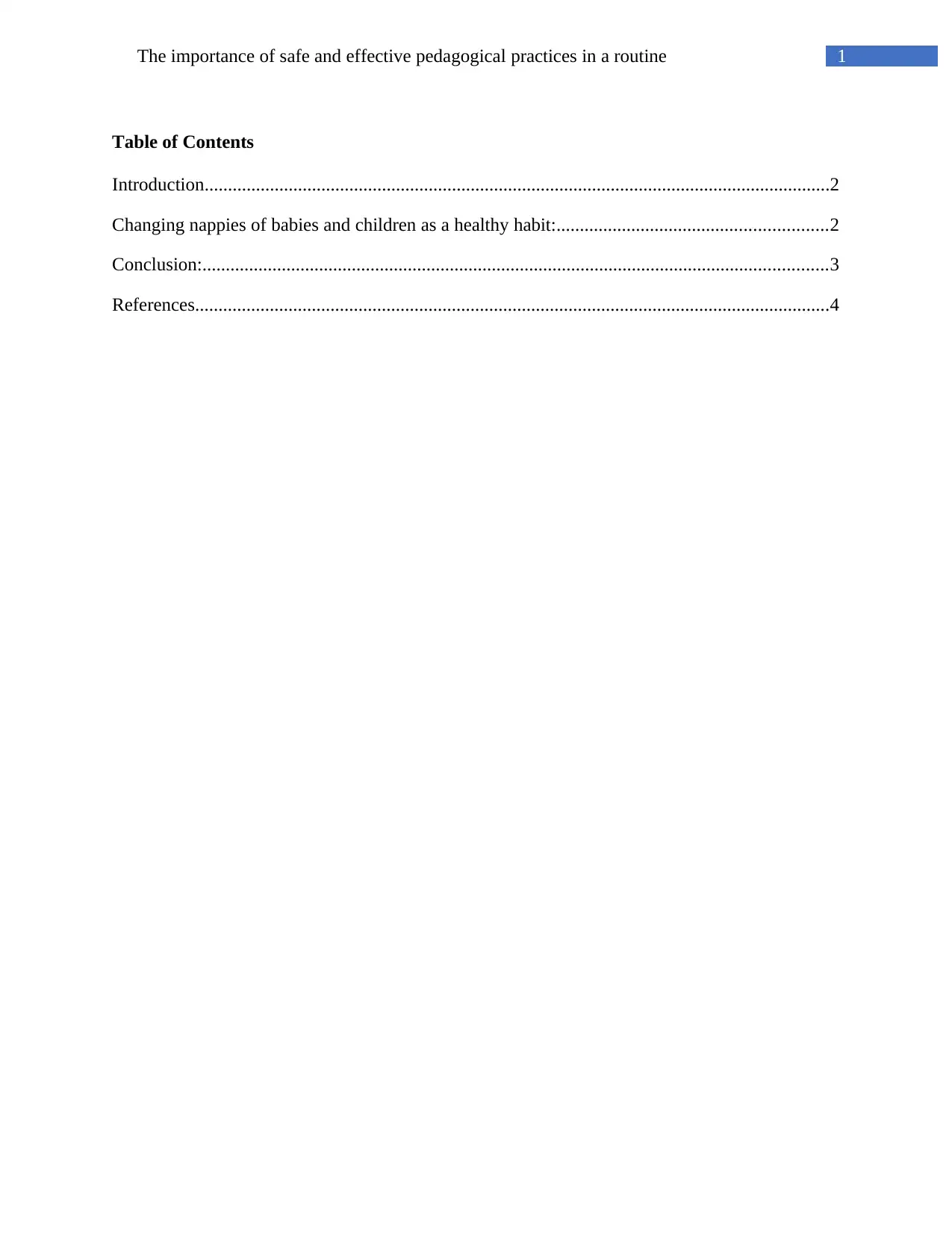
1The importance of safe and effective pedagogical practices in a routine
Table of Contents
Introduction......................................................................................................................................2
Changing nappies of babies and children as a healthy habit:..........................................................2
Conclusion:......................................................................................................................................3
References........................................................................................................................................4
Table of Contents
Introduction......................................................................................................................................2
Changing nappies of babies and children as a healthy habit:..........................................................2
Conclusion:......................................................................................................................................3
References........................................................................................................................................4
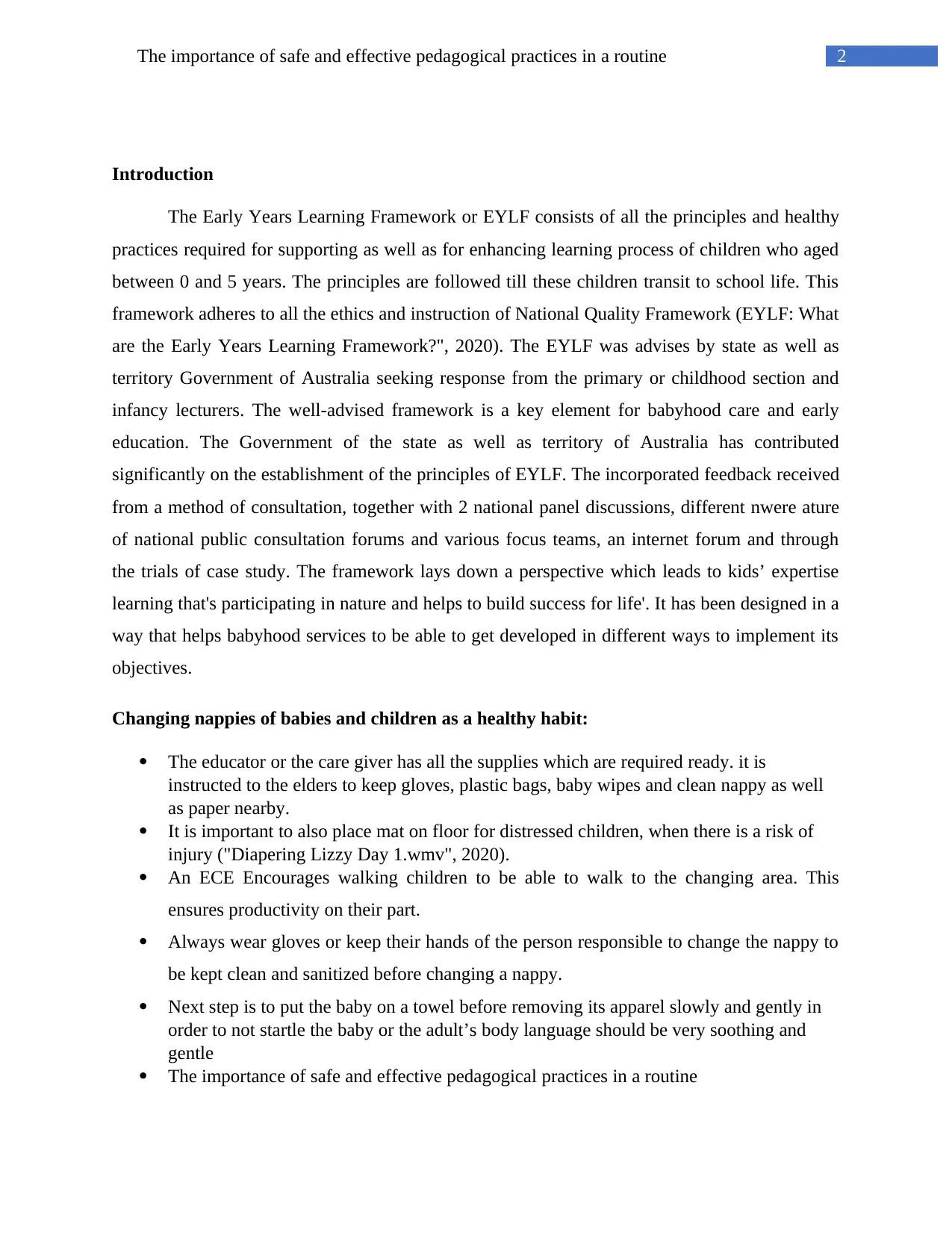
2The importance of safe and effective pedagogical practices in a routine
Introduction
The Early Years Learning Framework or EYLF consists of all the principles and healthy
practices required for supporting as well as for enhancing learning process of children who aged
between 0 and 5 years. The principles are followed till these children transit to school life. This
framework adheres to all the ethics and instruction of National Quality Framework (EYLF: What
are the Early Years Learning Framework?", 2020). The EYLF was advises by state as well as
territory Government of Australia seeking response from the primary or childhood section and
infancy lecturers. The well-advised framework is a key element for babyhood care and early
education. The Government of the state as well as territory of Australia has contributed
significantly on the establishment of the principles of EYLF. The incorporated feedback received
from a method of consultation, together with 2 national panel discussions, different nwere ature
of national public consultation forums and various focus teams, an internet forum and through
the trials of case study. The framework lays down a perspective which leads to kids’ expertise
learning that's participating in nature and helps to build success for life'. It has been designed in a
way that helps babyhood services to be able to get developed in different ways to implement its
objectives.
Changing nappies of babies and children as a healthy habit:
The educator or the care giver has all the supplies which are required ready. it is
instructed to the elders to keep gloves, plastic bags, baby wipes and clean nappy as well
as paper nearby.
It is important to also place mat on floor for distressed children, when there is a risk of
injury ("Diapering Lizzy Day 1.wmv", 2020).
An ECE Encourages walking children to be able to walk to the changing area. This
ensures productivity on their part.
Always wear gloves or keep their hands of the person responsible to change the nappy to
be kept clean and sanitized before changing a nappy.
Next step is to put the baby on a towel before removing its apparel slowly and gently in
order to not startle the baby or the adult’s body language should be very soothing and
gentle
The importance of safe and effective pedagogical practices in a routine
Introduction
The Early Years Learning Framework or EYLF consists of all the principles and healthy
practices required for supporting as well as for enhancing learning process of children who aged
between 0 and 5 years. The principles are followed till these children transit to school life. This
framework adheres to all the ethics and instruction of National Quality Framework (EYLF: What
are the Early Years Learning Framework?", 2020). The EYLF was advises by state as well as
territory Government of Australia seeking response from the primary or childhood section and
infancy lecturers. The well-advised framework is a key element for babyhood care and early
education. The Government of the state as well as territory of Australia has contributed
significantly on the establishment of the principles of EYLF. The incorporated feedback received
from a method of consultation, together with 2 national panel discussions, different nwere ature
of national public consultation forums and various focus teams, an internet forum and through
the trials of case study. The framework lays down a perspective which leads to kids’ expertise
learning that's participating in nature and helps to build success for life'. It has been designed in a
way that helps babyhood services to be able to get developed in different ways to implement its
objectives.
Changing nappies of babies and children as a healthy habit:
The educator or the care giver has all the supplies which are required ready. it is
instructed to the elders to keep gloves, plastic bags, baby wipes and clean nappy as well
as paper nearby.
It is important to also place mat on floor for distressed children, when there is a risk of
injury ("Diapering Lizzy Day 1.wmv", 2020).
An ECE Encourages walking children to be able to walk to the changing area. This
ensures productivity on their part.
Always wear gloves or keep their hands of the person responsible to change the nappy to
be kept clean and sanitized before changing a nappy.
Next step is to put the baby on a towel before removing its apparel slowly and gently in
order to not startle the baby or the adult’s body language should be very soothing and
gentle
The importance of safe and effective pedagogical practices in a routine
⊘ This is a preview!⊘
Do you want full access?
Subscribe today to unlock all pages.

Trusted by 1+ million students worldwide
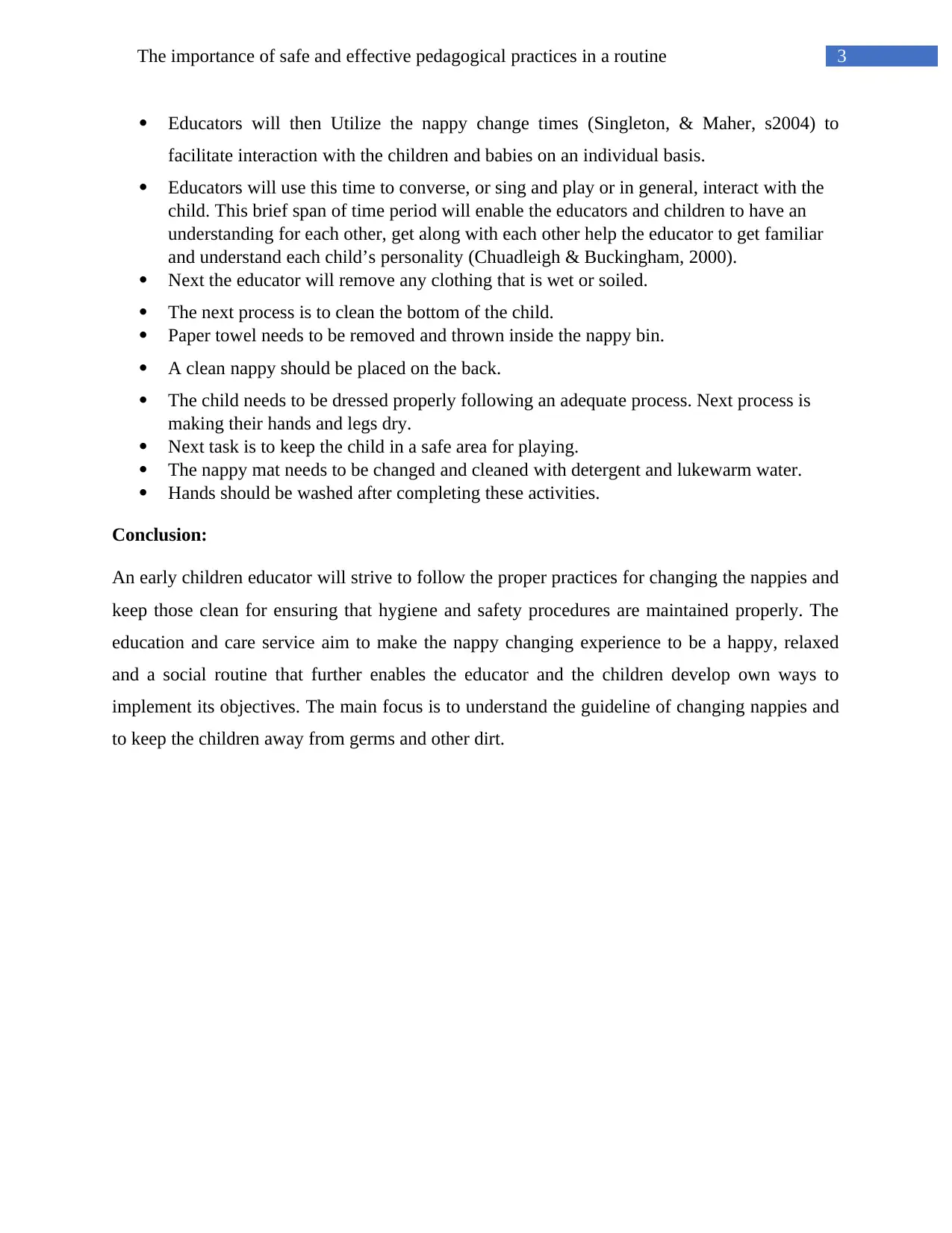
3The importance of safe and effective pedagogical practices in a routine
Educators will then Utilize the nappy change times (Singleton, & Maher, s2004) to
facilitate interaction with the children and babies on an individual basis.
Educators will use this time to converse, or sing and play or in general, interact with the
child. This brief span of time period will enable the educators and children to have an
understanding for each other, get along with each other help the educator to get familiar
and understand each child’s personality (Chuadleigh & Buckingham, 2000).
Next the educator will remove any clothing that is wet or soiled.
The next process is to clean the bottom of the child.
Paper towel needs to be removed and thrown inside the nappy bin.
A clean nappy should be placed on the back.
The child needs to be dressed properly following an adequate process. Next process is
making their hands and legs dry.
Next task is to keep the child in a safe area for playing.
The nappy mat needs to be changed and cleaned with detergent and lukewarm water.
Hands should be washed after completing these activities.
Conclusion:
An early children educator will strive to follow the proper practices for changing the nappies and
keep those clean for ensuring that hygiene and safety procedures are maintained properly. The
education and care service aim to make the nappy changing experience to be a happy, relaxed
and a social routine that further enables the educator and the children develop own ways to
implement its objectives. The main focus is to understand the guideline of changing nappies and
to keep the children away from germs and other dirt.
Educators will then Utilize the nappy change times (Singleton, & Maher, s2004) to
facilitate interaction with the children and babies on an individual basis.
Educators will use this time to converse, or sing and play or in general, interact with the
child. This brief span of time period will enable the educators and children to have an
understanding for each other, get along with each other help the educator to get familiar
and understand each child’s personality (Chuadleigh & Buckingham, 2000).
Next the educator will remove any clothing that is wet or soiled.
The next process is to clean the bottom of the child.
Paper towel needs to be removed and thrown inside the nappy bin.
A clean nappy should be placed on the back.
The child needs to be dressed properly following an adequate process. Next process is
making their hands and legs dry.
Next task is to keep the child in a safe area for playing.
The nappy mat needs to be changed and cleaned with detergent and lukewarm water.
Hands should be washed after completing these activities.
Conclusion:
An early children educator will strive to follow the proper practices for changing the nappies and
keep those clean for ensuring that hygiene and safety procedures are maintained properly. The
education and care service aim to make the nappy changing experience to be a happy, relaxed
and a social routine that further enables the educator and the children develop own ways to
implement its objectives. The main focus is to understand the guideline of changing nappies and
to keep the children away from germs and other dirt.
Paraphrase This Document
Need a fresh take? Get an instant paraphrase of this document with our AI Paraphraser
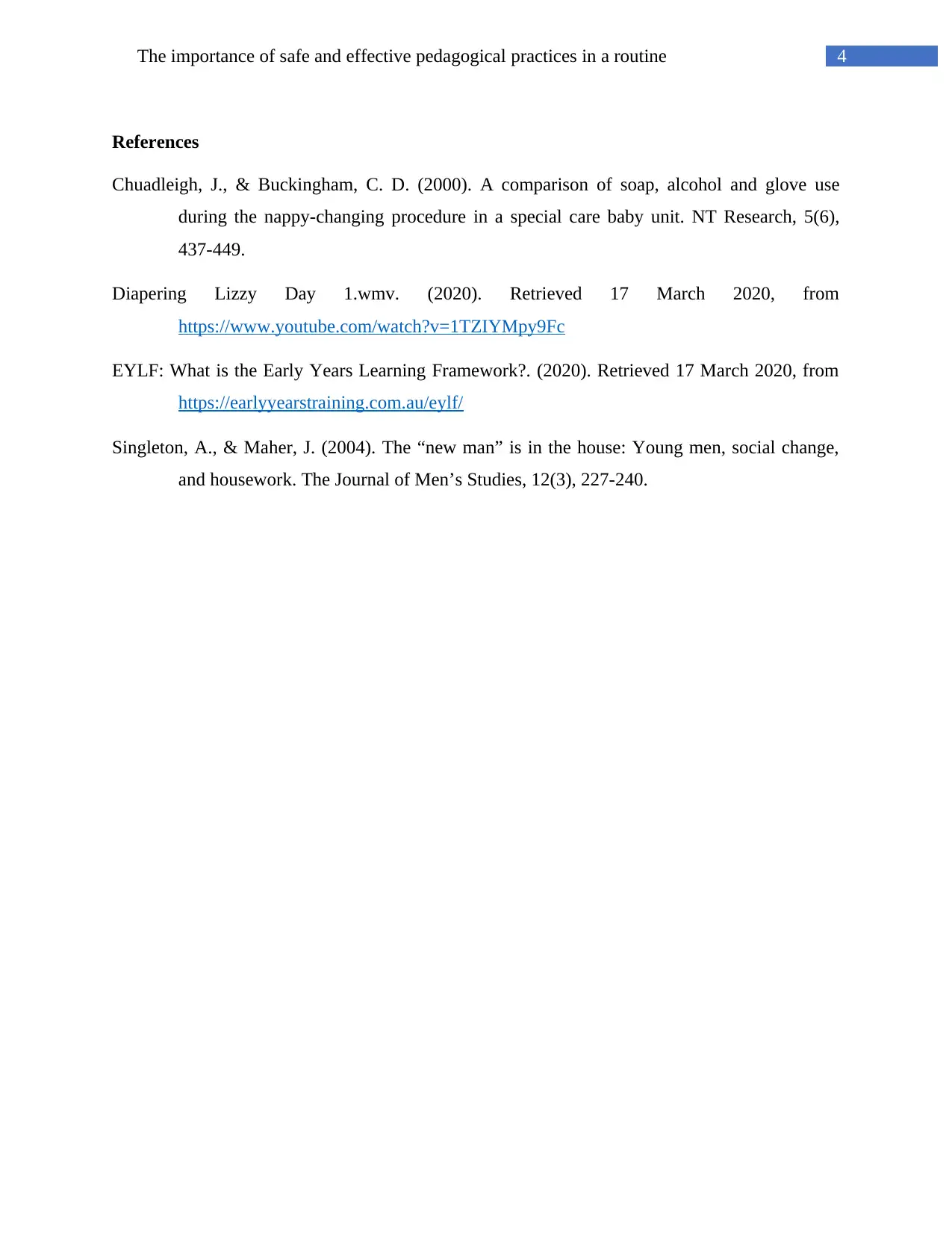
4The importance of safe and effective pedagogical practices in a routine
References
Chuadleigh, J., & Buckingham, C. D. (2000). A comparison of soap, alcohol and glove use
during the nappy-changing procedure in a special care baby unit. NT Research, 5(6),
437-449.
Diapering Lizzy Day 1.wmv. (2020). Retrieved 17 March 2020, from
https://www.youtube.com/watch?v=1TZIYMpy9Fc
EYLF: What is the Early Years Learning Framework?. (2020). Retrieved 17 March 2020, from
https://earlyyearstraining.com.au/eylf/
Singleton, A., & Maher, J. (2004). The “new man” is in the house: Young men, social change,
and housework. The Journal of Men’s Studies, 12(3), 227-240.
References
Chuadleigh, J., & Buckingham, C. D. (2000). A comparison of soap, alcohol and glove use
during the nappy-changing procedure in a special care baby unit. NT Research, 5(6),
437-449.
Diapering Lizzy Day 1.wmv. (2020). Retrieved 17 March 2020, from
https://www.youtube.com/watch?v=1TZIYMpy9Fc
EYLF: What is the Early Years Learning Framework?. (2020). Retrieved 17 March 2020, from
https://earlyyearstraining.com.au/eylf/
Singleton, A., & Maher, J. (2004). The “new man” is in the house: Young men, social change,
and housework. The Journal of Men’s Studies, 12(3), 227-240.
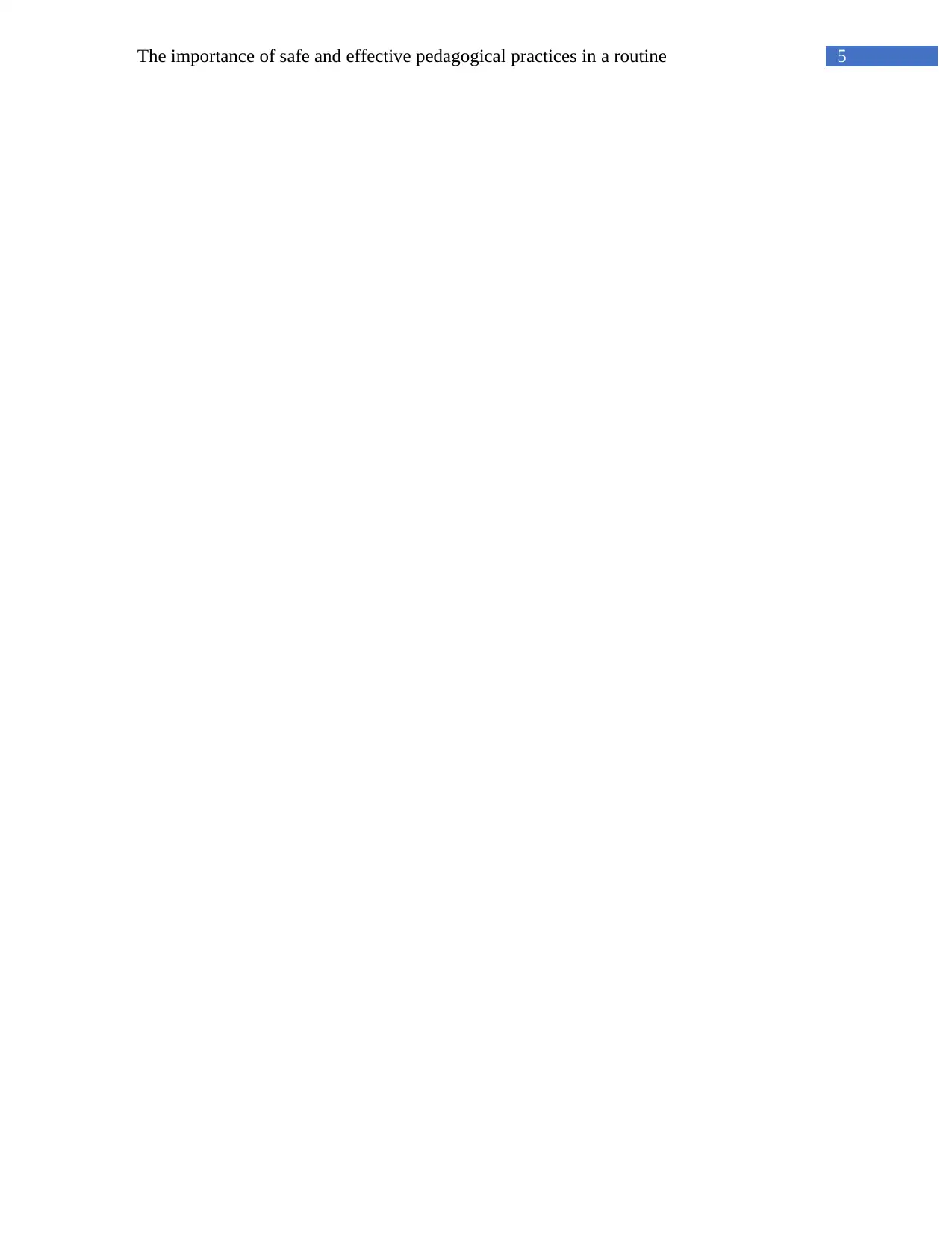
5The importance of safe and effective pedagogical practices in a routine
⊘ This is a preview!⊘
Do you want full access?
Subscribe today to unlock all pages.

Trusted by 1+ million students worldwide
1 out of 6
Related Documents
Your All-in-One AI-Powered Toolkit for Academic Success.
+13062052269
info@desklib.com
Available 24*7 on WhatsApp / Email
![[object Object]](/_next/static/media/star-bottom.7253800d.svg)
Unlock your academic potential
Copyright © 2020–2025 A2Z Services. All Rights Reserved. Developed and managed by ZUCOL.





